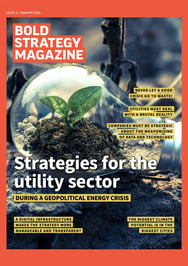A Roadmap to Climate Solutions and Sustainable Urban Development
.png)
In Part 1 of this blob, former Toronto Mayor David Miller explained that the battle against climate can be fought out in the world’s biggest cities where the effects of climate change can be drastic, but climate solutions can also be found.
In his book ‘Solved’, Miller, director of the C40 Centre for Urban Climate Policy & Economy - a global coalition of 100 major cities focused on meeting the Paris Convention to reduce global warming, describes the work and leadership of the C40 Mayors globally to combat the damaging effects of cities on climate and examining the biggest climate change potential in those cities.
A climate solution is necessary for all cities
Miller's book contains countless examples of bold city action, and his thesis is that if the best efforts can be spread to other cities with similar problems, it is indeed possible to get the world back on track by 2030 and on the road to net-zero emissions by 2050. He is convinced that this does not require massive innovative breakthroughs over the next eight years, but that it is about doing what is already being done right, in more places, quickly, and on a large scale.
On this point, too, he is optimistic, because the pace of change is accelerating in all cities right now. The C40 mayors are in the process of developing and implementing a climate solution with real actions for each city's 'fair share' of halving by 2030. The term 'fair share' is used very deliberately, as it is the cities in the northern hemisphere that have emitted and are emitting the largest share of greenhouse gases into the atmosphere.
Ideas spread to Denmark's municipalities
"Covid slowed things down a bit, but over the next year or two, all C40 members will have a plan that meets the goals. In the run-up to COP26 in Glasgow, another thousand cities across the world have committed to having a climate solution for their city and geographical area. As part of the program, these cities must accept external validation and outline the areas they will act on - most often buildings and transport. So the ideas from the biggest cities are spreading rapidly globally," says Miller.
"This is also true in Denmark thanks to Realdania, which is a partner of C40 and helps bring our ideas directly to municipalities across the country. So, there are 94 municipalities doing the same and developing climate action plans that are in line with the Paris Agreement. Denmark is doing very well as a country. Copenhagen is doing well. The ideas have spread to almost all of Denmark's smaller cities, and it's really changing the framework of what's possible."
Net-zero construction and improvement of existing buildings
Several major cities have committed to net-zero construction by 2030 - a goal that Miller admits will be difficult, but great strides are being made in that direction. In the Canadian city of Vancouver, building codes are likely to prevent underground parking lots from being built in tall buildings after 2030 because they won't be able to use the necessary amount of concrete. But since transport needs will not disappear, this also means that public transport will have to be expanded. In general, there is a lot of work being done in Vancouver on new buildings and whether they can function as net-zero or net-positive buildings.
"Ways also need to be found to make existing buildings much more energy efficient. New York City has been a leader in this, not least under Mayor Mike Bloomberg," says David Miller.
For example, requiring commercial buildings to disclose energy efficiency has yielded astonishing results in Class A buildings, what New York calls its best commercial buildings. It prompted tenants in less efficient buildings to demand improvements, and the Empire State Building, for example, underwent $200 million in energy retrofits. From a mayor's point of view, that's an extra good thing because it also creates jobs.
Congestion charging and procurement as policy instruments
In London, first a congestion charge for cars and then an ultra-low emission zone have been introduced. Mayor Sadiq Khan takes the view that emissions are not only a climate problem, but also a health problem.
"I was in London when the first ultra-low emission zone was announced, and it was fascinating. Transport companies were very unhappy with the tax, while many ordinary citizens supported it, and Mayor Khan was re-elected by a good margin after introducing the tax," explains David Miller. He notes that in many cities there is a general electrification of transport. He is also very encouraged by what is happening with the electricity grid itself.
"Some cities are joining forces when it comes to the electricity grid. Sydney and Melbourne in Australia, for example, are working with hospitals, universities, and other large electricity users on requirements for private utilities to buy only clean energy. This is already having a transformative effect on the electricity grid, and huge solar and wind projects are being built as cities use their purchasing power as a policy tool."
Mayors don't just care about a climate solution
Oslo in Norway and Tshwane in South Africa are in the process of a climate budget, in which they specify the amount of carbon that the city government must emit according to their climate solution. For example, if a new sports facility or library is to be built, a carbon quota is included in the budget in addition to the financial one, and if the quota cannot be allocated, the project cannot be built or operated.
"For me, it could be a principle that also applies to companies, governments, and municipalities, because it forces the system to deal with the fact that we can only emit a certain number of carbon emissions globally if we are to stay within 1.5 degrees," says David Miller.
As a man with two terms as mayor of a major city, Miller knows all about the role and its demands and ambitions, and he admits that mayors are not only concerned about the climate, but also about ensuring that their cities are attractive to all groups in society.
"Los Angeles is perhaps the best example of a climate plan that's full of ways to help people in low-income neighborhoods, whether it's through subsidies for short-term electric car rentals, car-sharing, job training in solar installation, and financial help for rooftop solar panels. That approach comes from going out and talking to people in low-income neighborhoods before the climate solution was drawn up."
Green shipping between Los Angeles and Shanghai
Miller also points to a potentially significant initiative in the future: the ports of Los Angeles and Shanghai, which have announced the first green shipping card between the two cities - the busiest cargo shipping route in the world. "It starts modestly with a single ship, but it could lead to significant changes when Maersk and others follow suit and start doing the same," he says.
Reduction and phase-out of gas are also receiving increasing attention. A C40 team led by Rachel Huxley recently published research on the impacts of natural gas and the need for cities to phase out fossil gas. Here, Los Angeles is again leading the way with an electricity grid to be gas-free by 2029 and completely green by 2031 - Barcelona and Johannesburg are following suit.
"Rachel's report is important for the global understanding that gas cannot replace green energy. Despite all the promises to reach the 1.5 scenario, there are still massive gaps and significant gas expansion is taking place which will make this gap even bigger. To reach the 1.5-degree target we need to cut consumption by 30%, but right now it is rising. And we can't reach it if we keep expanding gas consumption," Miller points out.
The most sustainable cities are those that grow inwards
If you ask David Miller to highlight a city that could be a model for how to drive green transformation, he could quite rightly point to his home city of Toronto, which has done well on many parameters. Yet he singles out Oslo and Tshwane because of their innovative climate budgets and because, in his view, that is essentially what the world needs to do. "Tshwane in South Africa shows that it is not only possible in Northern Europe, but that it can be spread globally," Miller says.
And for mayors of all cities, David Miller has this advice: "Take note of all that is happening in transport and especially buildings worldwide and learn from it. Many cities in North America are growing almost infinitely outward. But the best and most sustainable cities are those that seek to grow inward because it makes walking, cycling, and public transport more attractive, and you get the economic benefits of density. You also get a more interesting place to live, and you get a place that is much kinder to the planet."
Through his role as Executive Director of the C40 Centre for Urban Climate Policy & Economy, David Miller has seen first hand both the problems caused by cities on climate change and solution-finding capabilities and vision shared by many of the world’s biggest cities. And the fact that he is encouragingly optimistic, is because he has seen the potential, the willingness, the ideas and the leadership of city leaders and shapers. The strategies that are developing, the actions that are being studied and the lessons being learned and shared globally give the former Mayor of Toronto reason to believe that ‘where there is a will, there is a way’ and there is very definitely the will at the highest levels in the world’s biggest cities.
For additional insights on how to have a climate solution, download for free the Bold Strategy Magazine. This magazine focuses on the strategies for the utility sector, which nowadays is a very relevant and important matter. Stay on top of the changes!



.png?width=596&name=Climate%20Change%20(1).png)






.png?width=80&name=USED%20(1).png)